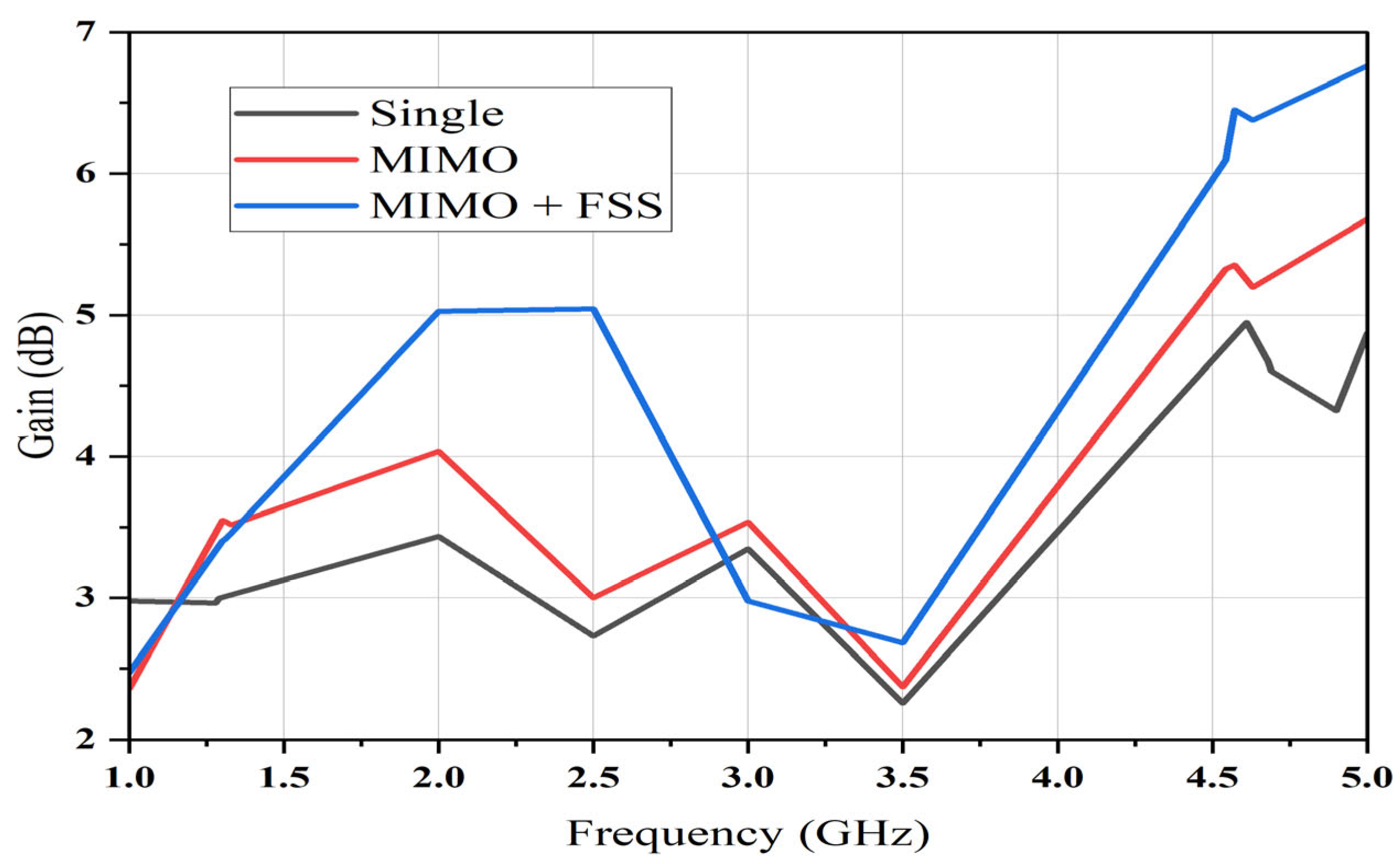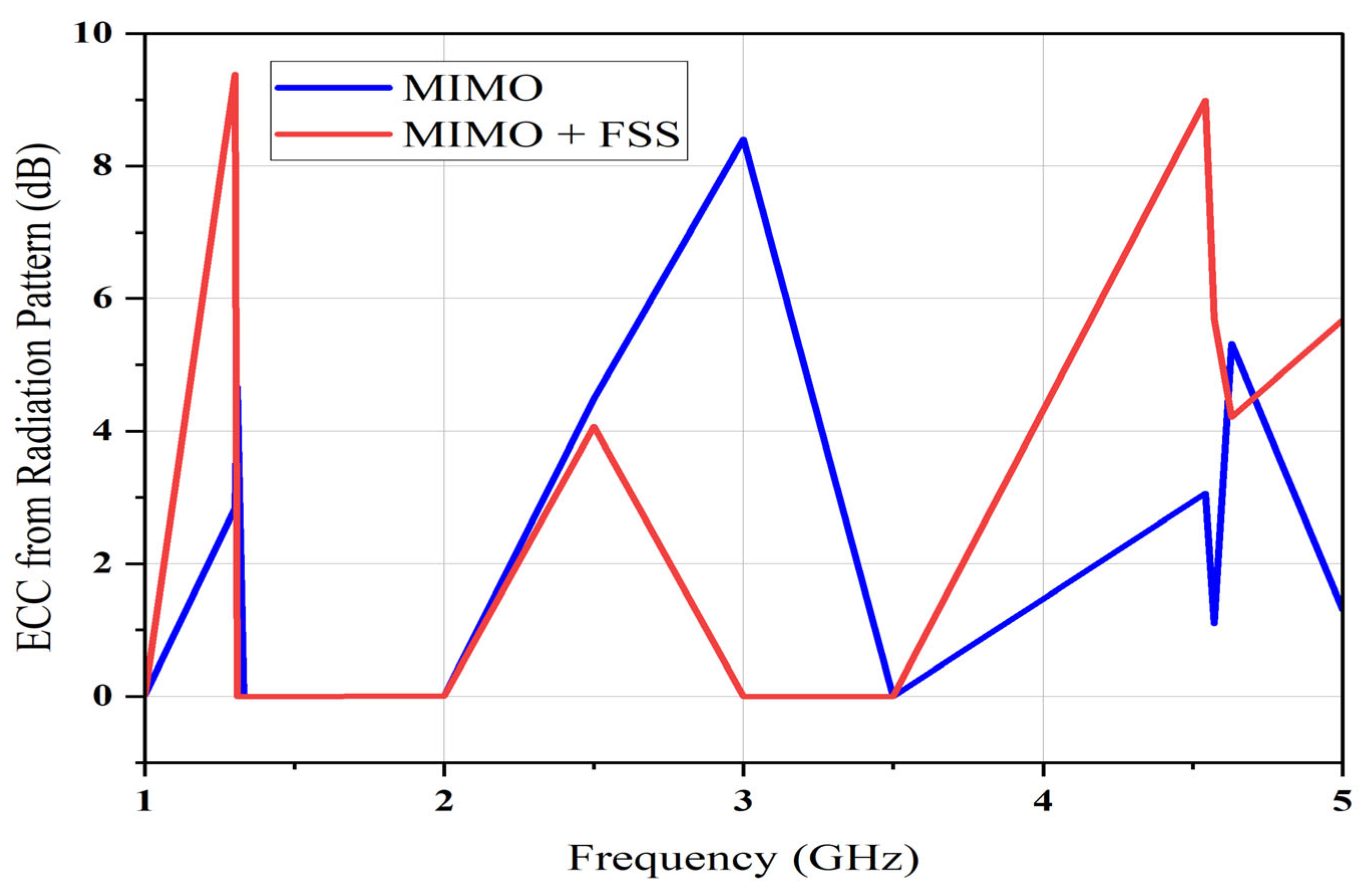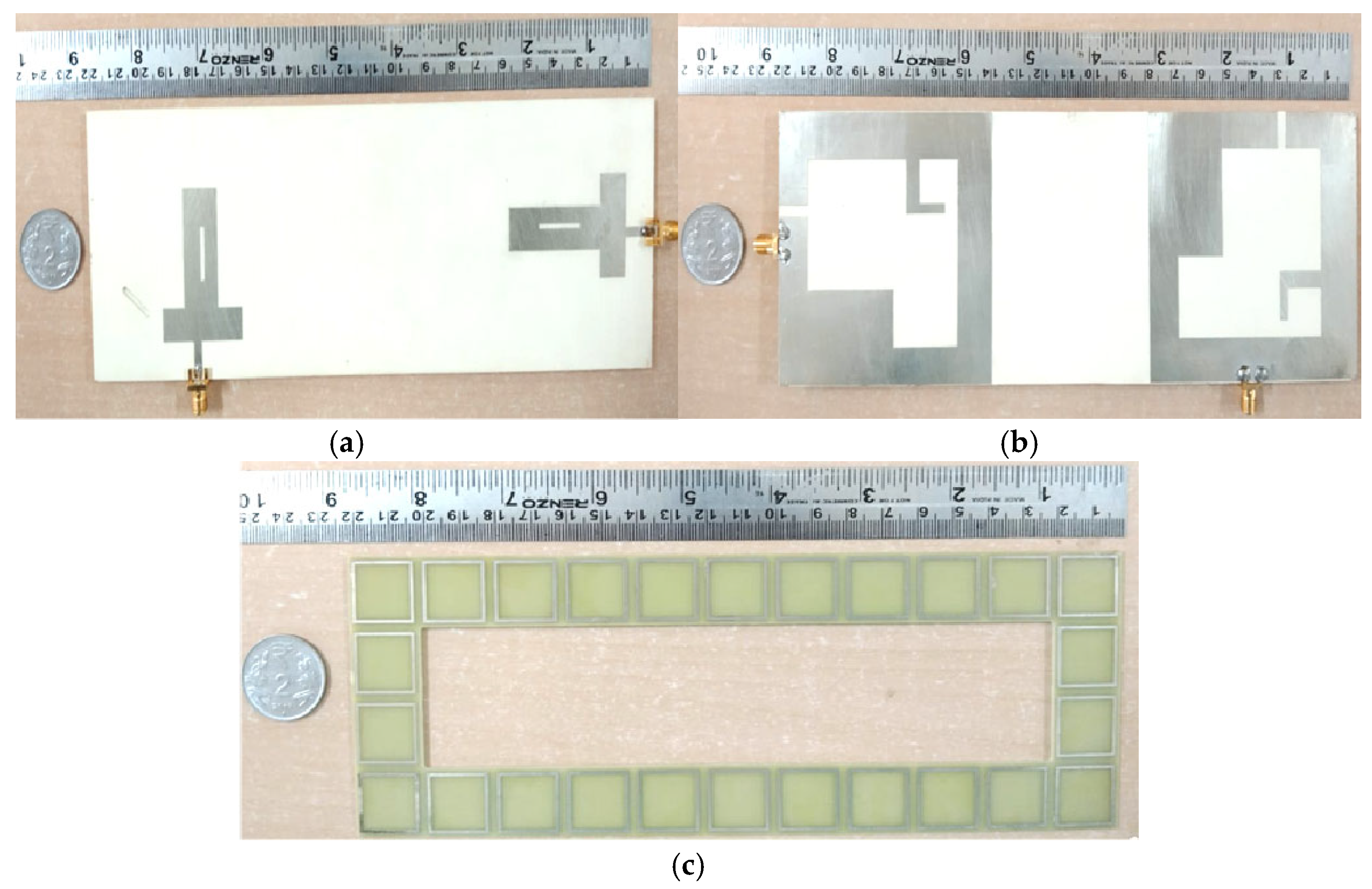Multi-Band Unmanned Aerial Vehicle Antenna for Integrated 5G and GNSS Connectivity
Abstract
1. Introduction
- ○
- A single-port inverted T-shaped antenna with defected ground was designed to resonate in the GNSS and 5G bands with circular polarization.
- ○
- Appropriate orthogonal placement of a dual-port MIMO antenna to reduce the electromagnetic interaction among the antenna structures.
- ○
- A single square ring-shaped frequency selective surface (FSS) was designed for broadband coverage.
- ○
- Investigation of an FSS integrated dual-port MIMO antenna for outdoor 5G and GNSS applications.
2. Dual-Port Inverted T-Shaped MIMO Antenna and Analysis
2.1. Gain Parameter Analysis
2.2. Axial Ratio Parameter Analysis
2.3. VSWR Parameter Analysis
2.4. Envelope Correlation Coefficient
2.5. Diversity Gain
2.6. Mean Effective Gain
2.7. Total Active Reflection Coefficient
2.8. Current Distribution
3. Conclusions
Author Contributions
Funding
Data Availability Statement
Conflicts of Interest
Abbreviations
| MIMO | Multiple-input and multiple-output |
| FSS | Frequency selective surface |
| VSWR | Voltage standing wave ratio |
| GNSS | Global navigation satellite system |
| TARC | Total active reflection coefficient |
| MEG | Mean effective gain |
| ECC | Envelope correlation coefficient |
| V2X | Vehicle-to-everything |
| WLAN | Wireless local area network |
| CCL | Channel capacity loss |
References
- Liu, X.; Wang, H.; Yang, X.; Wang, J. Quad-Band Circular Polarized Antenna for GNSS, 5G and WIFI-6E Applications. Electronics 2022, 11, 1133. [Google Scholar] [CrossRef]
- Chandra, R.J.; Ali, T.; Kumar, O.; Pai, M.M. A planar rectangular slot multi-band patch antenna for GNSS/WLAN/X-band applications. Mater. Today Proc. 2020, 28, 2279–2285. [Google Scholar] [CrossRef]
- Ibrahim, A.S.; Yacoub, A.M.; Aloi, D.N. A 3-dimensional multi-band antenna for vehicular 5G sub-6 GHz/GNSS/V2X applications. Int. J. Antennas Propag. 2022, 2022, 5609110. [Google Scholar] [CrossRef]
- Tiwari, P.; Gahlaut, V.; Kaushik, M.; Rani, P.; Shastri, A.; Singh, B. Advancing 5G connectivity: A comprehensive review of MIMO antennas for 5G applications. Int. J. Antennas Propag. 2023, 2023, 5906721. [Google Scholar] [CrossRef]
- Jiang, J.-Y.; Su, H.-L. A wideband eight-element MIMO antenna array in 5G NR n77/78/79 and WLAN-5GHz bands for 5G smartphone applications. Int. J. Antennas Propag. 2022, 2022, 8456936. [Google Scholar] [CrossRef]
- Wang, L.; Yao, B.; Fang, W.; Huang, C.; Huang, Y.; En, Y. New Circular-Slot Circularly Polarized Antenna with Modified Characteristic. Int. J. Antennas Propag. 2022, 2022, 5458069. [Google Scholar] [CrossRef]
- Chang, L.; Wang, H. Dual-Band Four-Antenna Module Covering N78/N79 Based on PIFA for 5G Terminals. IEEE Antennas Wirel. Propag. Lett. 2022, 21, 168–172. [Google Scholar] [CrossRef]
- Ali, H.; Ren, X.-C.; Bari, I.; Bashir, M.A.; Hashmi, A.M.; Khan, M.A.; Majid, S.I.; Jan, N.; Tareen, W.U.K.; Anjum, M.R. Four-Port MIMO Antenna System for 5G n79 Band RF Devices. Electronics 2022, 11, 35. [Google Scholar] [CrossRef]
- Abdul-Rahman, E.; Aloi, D.N. Design of a multi-function global navigation satellite system and 5G cellular antenna structure for automotive applications using characteristic mode analysis. IET Microw. Antennas Propag. 2023, 17, 863–871. [Google Scholar] [CrossRef]
- Madni, A.; Khan, W.T. Design of a Compact 4-Element GNSS Antenna Array With High Isolation Using a Defected Ground Structure (DGS) and a Microwave Absorber. IEEE Open J. Antennas Propag. 2023, 4, 779–791. [Google Scholar] [CrossRef]
- Yacoub, A.; Aloi, D.N. Low-Profile Automotive Antenna Systems for MIMO 5G and L1/L5 GNSS Communications. In Proceedings of the 2022 16th European Conference on Antennas and Propagation (EuCAP), Madrid, Spain, 27 March–1 April 2022; pp. 1–4. [Google Scholar] [CrossRef]
- Du, K.; Wang, Y.; Zhang, L.; Hu, Y. Design of Wideband Decoupling Antenna Pairs for 5G Portable Devices at N77/N78/N79 Bands. Micromachines 2022, 13, 1964. [Google Scholar] [CrossRef] [PubMed]
- Ali, A.; Munir, M.E.; Marey, M.; Mostafa, H.; Zakaria, Z.; Al-Gburi, A.J.A.; Bhatti, F.A. A Compact MIMO Multi-band Antenna for 5G/WLAN/WIFI-6 Devices. Micromachines. 2023, 14, 1153. [Google Scholar] [CrossRef] [PubMed]
- Addepalli, T.; Desai, A.; Elfergani, I.; Anveshkumar, N.; Kulkarni, J.; Zebiri, C.; Rodriguez, J.; Abd-Alhameed, R. 8-Port Semicircular Arc MIMO Antenna with an Inverted L-Strip Loaded Connected Ground for UWB Applications. Electronics 2021, 10, 1476. [Google Scholar] [CrossRef]
- Ahmad, S.; Khan, S.; Manzoor, B.; Soruri, M.; Alibakhshikenari, M.; Dalarsson, M.; Falcone, F. A Compact CPW-Fed Ultra-Wideband Multi-Input-Multi-Output (MIMO) Antenna for Wireless Communication Networks. IEEE Access. 2022, 10, 25278–25289. [Google Scholar] [CrossRef]
- Shoaib, N.; Shoaib, S.; Khattak, R.Y.; Shoaib, I.; Chen, X.; Perwaiz, A. MIMO Antennas for Smart 5G Devices. IEEE Access. 2018, 6, 77014–77021. [Google Scholar] [CrossRef]
- Nadar, K.P.; Jeyaprakasam, V.; Mariapushpam, I.T.; Vivekanand, C.V.; Eswaralingam, A.D.; Louis, M.T.; Raj, J.X.A.; Jibril, H.A.; Chellappa, A.S.; Muthukutty, R.K.; et al. Design and Analysis of Microstrip Patch Antenna Array and Electronic Beam Steering Linear Phased Antenna Array with High Directivity for Space Applications. ACS Omega 2023, 8, 43197–43217. [Google Scholar] [CrossRef] [PubMed]
- Kumar, A.; Pattanayak, P.; Verma, R.K.; Sabat, D.; Prasad, G. Two-element MIMO antenna system for multi-band millimeter-wave, 5G mobile communication, Ka-band, and future 6G applications with SAR analysis. AEU-Int. J. Electron. Commun. 2023, 171, 154876. [Google Scholar] [CrossRef]
- Sharma, P.; Tiwari, R.N.; Singh, P.; Kumar, P.; Kanaujia, B.K. MIMO Antennas: Design Approaches, Techniques and Applications. Sensors 2022, 22, 7813. [Google Scholar] [CrossRef] [PubMed]
- Gharaati, A.; Ghaffarian, M.S.; Mirzavand, R. Transparent Wideband Circularly Polarized GNSS Antenna for Vehicular Applications. IEEE Access. 2021, 9, 130185–130198. [Google Scholar] [CrossRef]

























| Reference | Dimensions (mm) | Material | Frequency | Gain (dBi) | Antenna Type | Polarization |
|---|---|---|---|---|---|---|
| [1] | 80 × 80 × 1.6 | FR4 | WIFI-6E, 5G, n77, n78, and GNSS | 4.56, 2.28, 4.26, and 4.30 | Single | CP |
| [2] | 60 × 60 × 1.6 | FR4 | GNSS, WLAN, X | 5.7, 3.79, and 5.4 | Single | - |
| [3] | 58 × 37 × 17 | FR4 | GNSS | 3 | Single | - |
| [5] | 150 × 75 × 7.8 | FR4 | (n77/n78/n79) and WLAN | - | MIMO | - |
| [6] | 50 × 50 × 0.8 | - | 6 GHz | 4.52 | Single | RHCP |
| [8] | 40 × 40 | FR4 | 5G n78 | 2.8 | MIMO | - |
| [9] | 75 × 50 × 30 | FR4 | GNSS L1, 5G | 5.2 and 3.9 | Single | RHCP and LP |
| [10] | 125(R) × 5.08 | Rogers TMM10i | GNSS | 6 | MIMO | RHCP |
| [12] | 28 × 6 | FR4 | 5G-n77/n78/n79 | 4.2–8.2 | MIMO | - |
| [13] | 16 × 28 × 1.6 | FR4 | 5.5, 5.5, and 6.5 GHz | 2.24, 3.49, and 3.41 | MIMO | - |
| [14] | 61 × 61 × 1.6 | FR4 | 3.1, 4.7, 6.9 and 9.5 GHz | 5.6 | MIMO | - |
| [15] | 60 × 60 × 1.6 | FR4 | 3–11 GHz | 3.4 | MIMO | - |
| [16] | 312 × 312 × 157 | Rogers RT-5880 | 25.2 GHz | 8.7 | MIMO | - |
| [17] | 40 × 50 × 0.8 | Rogers RT-5880 | 4.17 GHz | 7.01 | MIMO | - |
| Proposed | 40 × 80 × 3.2 | TUC803B | GNSS, 5G n79 | 5.44 and 6.43 | MIMO | CP and LP |
| Parameters | Value (mm) | Parameters | Value (mm) |
|---|---|---|---|
| Width (G) | 80 | W5 | 13 |
| Length (G) | 80 | L5 | 14.5 |
| H | 4 | W6 | 16 |
| W1 | 11 | L6 | 35.5 |
| L1 | 13 | W7 | 3 |
| W2 | 14 | L7 | 10 |
| L2 | 11 | W8 | 31 |
| W3 | 28 | L8 | 11 |
| L3 | 32 | W9 | 13 |
| W4 | 49.5 | W10 | 8.5 |
| L4 | 14.5 |
| Parameters | Values (mm) |
|---|---|
| W | 20 |
| L | 20 |
| W1 | 17.5 |
| L1 | 17.5 |
| W2 | 15.5 |
| L2 | 15.5 |
| Antenna Type | Substrate Material | Resonant Frequency (GHz) | S11 (dB) | Gain (dB) | Axial Ratio (dB) | ECC (S-Parameter) | ECC (Radiation Pattern) | DG | MEG | VSWR |
|---|---|---|---|---|---|---|---|---|---|---|
| Single-patch antenna | Schott Foturan II (Ceramized 560 degree), 4 mm thick, dielectric constant = 5.8 | 1.28 | −16.857 | 2.2871 | 1.509 | - | - | - | - | 1.3353 |
| 4.69 | −14.069 | 2.2042 | 6.6577 | - | - | - | - | 1.4936 | ||
| MIMO antenna | 1.3 | −16.038 | 2.5778 | 1.4359 | 0.00016228 | 0.00028412 | 9.9992 | −3.0103 | 1.3747 | |
| 4.68 | −14.063 | 2.6982 | 8.8713 | 1.481 × 10−5 | 0.00076537 | 9.9999 | −3.0103 | 1.4941 | ||
| MIMO + FSS antenna (normal) | 1.28 | −16.835 | 2.8426 | 1.1053 | 0.0003222 | 0.00051789 | 9.9984 | −3.0103 | 1.3363 | |
| 4.55 | −21.954 | 3.3108 | 4.3112 | 1.0862 × 10−5 | 0.00053167 | 9.9999 | −3.0103 | 1.1736 | ||
| Taconic RF60A, 3.2 mm thick, dielectric constant = 6.2 | 1.29 | −13.319 | 3.2052 | 3.4422 | 0.00037898 | 0.00060761 | 9.9981 | −3.0103 | 1.5504 | |
| 4.57 | −26.768 | 5.8745 | 13.874 | 4.8072 × 10−6 | 0.0007488 | 10 | −3.0103 | 1.0962 | ||
| TUC803B, 3.2 mm thick, dielectric constant = 6.2 | 1.302 | −14.149 | 3.4024 | 3.9655 | 0.00065812 | 0.00093826 | 9.9967 | −3.0103 | 1.488 | |
| 4.571 | −25.866 | 6.4517 | 13.91 | 2.3439 × 10−7 | 0.0005693 | 10 | −3.0103 | 1.1073 |
Disclaimer/Publisher’s Note: The statements, opinions and data contained in all publications are solely those of the individual author(s) and contributor(s) and not of MDPI and/or the editor(s). MDPI and/or the editor(s) disclaim responsibility for any injury to people or property resulting from any ideas, methods, instructions or products referred to in the content. |
© 2025 by the authors. Licensee MDPI, Basel, Switzerland. This article is an open access article distributed under the terms and conditions of the Creative Commons Attribution (CC BY) license (https://creativecommons.org/licenses/by/4.0/).
Share and Cite
Gunasekaran, S.; Chinnusami, M.; Anbazhagan, R.; Sureshkumar, K.; Sridhar, S. Multi-Band Unmanned Aerial Vehicle Antenna for Integrated 5G and GNSS Connectivity. Telecom 2025, 6, 38. https://doi.org/10.3390/telecom6020038
Gunasekaran S, Chinnusami M, Anbazhagan R, Sureshkumar K, Sridhar S. Multi-Band Unmanned Aerial Vehicle Antenna for Integrated 5G and GNSS Connectivity. Telecom. 2025; 6(2):38. https://doi.org/10.3390/telecom6020038
Chicago/Turabian StyleGunasekaran, Suguna, Manikandan Chinnusami, Rajesh Anbazhagan, Karunyaa Sureshkumar, and Shreela Sridhar. 2025. "Multi-Band Unmanned Aerial Vehicle Antenna for Integrated 5G and GNSS Connectivity" Telecom 6, no. 2: 38. https://doi.org/10.3390/telecom6020038
APA StyleGunasekaran, S., Chinnusami, M., Anbazhagan, R., Sureshkumar, K., & Sridhar, S. (2025). Multi-Band Unmanned Aerial Vehicle Antenna for Integrated 5G and GNSS Connectivity. Telecom, 6(2), 38. https://doi.org/10.3390/telecom6020038






